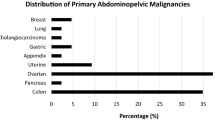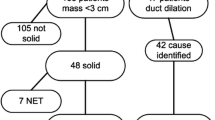Abstract
Objectives
Peritoneal carcinomatosis (PC) is a prognostically relevant metastatic disease which may be difficult to depict in postoperative patients, particularly in early stages. This study aimed to determine whether PC could be diagnosed more accurately when using a combination of spectral detector CT (SDCT)-derived conventional images (CI) and iodine overlay images (IO) compared with CI only.
Methods
Thirty patients with PC and 30 patients with benign peritoneal alterations (BPA) who underwent portal-venous abdominal SDCT were included. Four radiologists determined the presence/absence of PC for each patient and assessed lesion conspicuity, diagnostic certainty, and image quality using 5-point Likert scales. Subjective assessment was conducted in two sessions comprising solely CI and CI/IO between which a latency of 6 weeks was set. Iodine uptake and HU attenuation were determined ROI-based to analyze quantitative differentiation of PC/BPA.
Results
Specificity for PC was significantly higher when using CI/IO compared with using CI only (0.86 vs. 0.78, p ≤ 0.05), while sensitivity was comparable (0.79 vs. 0.81, p = 1). In postoperative patients, the increase in specificity was the highest (0.93 vs. 0.80, p ≤ 0.05). Lesion conspicuity was rated higher in CI/IO (4 (3–5)) compared with that in CI only (3 (3–4); p ≤ 0.05). Diagnostic certainty was comparable (both 4 (3–5); p = 0.5). CI/IO received the highest rating for overall image quality and assessability (CI/IO 5 (4–5) vs. CI 4 (4–4) vs. IO 4 (3–4); p ≤ 0.05). Area under the receiver operating characteristics curve (AUC) for quantitative differentiation between PC and BPA was higher for iodine (AUCIodine = 0.95, AUCHU = 0.90).
Conclusions
Compared with CI, combination of CI/IO improves specificity in the assessment of peritoneal carcinomatosis at comparable sensitivity, particularly in postoperative patients.
Key Points
• Combination of iodine overlays and conventional images improves specificity when assessing patients with peritoneal carcinomatosis at comparable sensitivity.
• Particularly in postsurgical patients, iodine overlays could help to avoid false-positive diagnosis of peritoneal disease.
• Iodine overlays alone provided inferior image quality and assessability than conventional images, while the combination of both received the highest ratings. Iodine overlays should therefore be used in addition to and not as a substitute for conventional images.




Similar content being viewed by others
Abbreviations
- AUC:
-
Area under the receiver operating characteristics curve
- BPA:
-
Benign peritoneal alterations
- CI:
-
Conventional images
- CT:
-
Computed tomography
- DECT:
-
Dual-energy CT
- IO:
-
Iodine overlays
- PC:
-
Peritoneal carcinomatosis
- ROI:
-
Region of interest
- SDCT:
-
Spectral detector computed tomography
References
Klaver YLB, Lemmens VE, Nienhuijs SW, Luyer MDP, de Hingh IH (2012) Peritoneal carcinomatosis of colorectal origin: incidence, prognosis and treatment options. World J Gastroenterol 18(39):5489–5494
Segelman J, Granath F, Holm T, Machado M, Mahteme H, Martling A (2012) Incidence, prevalence and risk factors for peritoneal carcinomatosis from colorectal cancer. Br J Surg 99(5):699–705
Coccolini F, Gheza F, Lotti M et al (2013) Peritoneal carcinomatosis. World J Gastroenterol 19(41):6979–6994
Desai JP, Moustarah F (2019) Cancer, Peritoneal Metastasis. StatPearls Publishing
Goéré D, Gelli M (2016) Treatment of colorectal peritoneal metastases requires multidisciplinary efforts. Lancet Oncol 17(12):1630–1631
Razenberg LG, van Gestel YR, Creemers GJ, Verwaal VJ, Lemmens VE, de Hingh IH (2015) Trends in cytoreductive surgery and hyperthermic intraperitoneal chemotherapy for the treatment of synchronous peritoneal carcinomatosis of colorectal origin in the Netherlands. Eur J Surg Oncol 41(4):466–471
Schmidt S, Meuli RA, Achtari C, Prior JO (2015) Peritoneal carcinomatosis in primary ovarian cancer staging: comparison between MDCT, MRI, and 18F-FDG PET/CT. Clin Nucl Med 40(5):371–377
Koh JL, Yan TD, Glenn D, Morris DL (2009) Evaluation of preoperative computed tomography in estimating peritoneal cancer index in colorectal peritoneal carcinomatosis. Ann Surg Oncol 16(2):327–333
Levy AD, Shaw JC, Sobin LH (2009) Secondary tumors and tumorlike lesions of the peritoneal cavity: imaging features with pathologic correlation. Radiographics 29(2):347–373
Dromain C, Leboulleux S, Auperin A et al (2008) Staging of peritoneal carcinomatosis: enhanced CT vs. PET/CT. Abdom Imaging 33(1):87–93
Esquivel J, Chua TC, Stojadinovic A et al (2010) Accuracy and clinical relevance of computed tomography scan interpretation of peritoneal cancer index in colorectal cancer peritoneal carcinomatosis: a multi-institutional study. J Surg Oncol 102(6):565–570
Low RN, Barone RM, Lucero J (2015) Comparison of MRI and CT for predicting the peritoneal cancer index (PCI) preoperatively in patients being considered for cytoreductive surgical procedures. Ann Surg Oncol 22(5):1708–1715
Brokelman WJ, Lensvelt M, Borel Rinkes IH, Klinkenbijl JH, Reijnen MM (2011) Peritoneal changes due to laparoscopic surgery. Surg Endosc 25(1):1–9
Große Hokamp N, Höink AJ, Doerner J et al (2018) Assessment of arterially hyper-enhancing liver lesions using virtual monoenergetic images from spectral detector CT: phantom and patient experience. Abdom Radiol (NY) 43(8):2066–2074
Albrecht MH, Scholtz JE, Kraft J et al (2015) Assessment of an advanced monoenergetic reconstruction technique in dual-energy computed tomography of head and neck cancer. Eur Radiol 25(8):2493–2501
Mileto A, Marin D, Alfaro-Cordoba M et al (2014) Iodine quantification to distinguish clear cell from papillary renal cell carcinoma at dual-energy multidetector CT: a multireader diagnostic performance study. Radiology 273(3):813–820
Lennartz S, Le Blanc M, Zopfs D et al (2019) Dual-energy CT-derived iodine Maps: Use in Assessing Pleural Carcinomatosis. Radiology. https://doi.org/10.1148/radiol.2018181567
Uhrig M, Simons D, Bonekamp D, Schlemmer H-P (2017) Improved detection of melanoma metastases by iodine maps from dual energy CT. Eur J Radiol 90:27–33
Muenzel D, Lo GC, Yu HS et al (2017) Material density iodine images in dual-energy CT: detection and characterization of hypervascular liver lesions compared to magnetic resonance imaging. Eur J Radiol 95:300–306
McCollough CH, Leng S, Yu L, Fletcher JG (2015) Dual- and multi-energy CT: principles, technical approaches, and clinical applications. Radiology 276(3):637–653
Rassouli N, Etesami M, Dhanantwari A, Rajiah P (2017) Detector-based spectral CT with a novel dual-layer technology: principles and applications. Insights Imaging 8(6):589–598
Große Hokamp N, Maintz D, Shapira N, Chang DH, Noel PB (2019) Technical background of a novel detector-based approach to dual-energy computed tomography. Diagn Interv Radiol. https://doi.org/10.5152/dir.2019.19136
Fagerland MW, Lydersen S, Laake P (2013) The McNemar test for binary matched-pairs data: mid- p and asymptotic are better than exact conditional. BMC Med Res Methodol 13(1):1–8
DeLong ER, DeLong DM, Clarke-Pearson DL (1988) Comparing the areas under two or more correlated receiver operating characteristic curves: a nonparametric approach. Biometrics 44(3):837–845
Arung W, Meurisse M, Detry O (2011) Pathophysiology and prevention of postoperative peritoneal adhesions. World J Gastroenterol 17(41):4545–4553
Laghi A, Bellini D, Rengo M et al (2017) Diagnostic performance of computed tomography and magnetic resonance imaging for detecting peritoneal metastases: systematic review and meta-analysis. Radiol Med 122(1):1–15
Rubini G, Altini C, Notaristefano A et al (2014) Role of 18F-FDG PET/CT in diagnosing peritoneal carcinomatosis in the restaging of patient with ovarian cancer as compared to contrast enhanced CT and tumor marker Ca-125. Rev Esp Med Nucl Imagen Mol 33(1):22–27
Kim HW, Won KS, Zeon SK, Ahn BC, Gayed IW (2013) Peritoneal carcinomatosis in patients with ovarian cancer: enhanced CT versus 18F-FDG PET/CT. Clin Nucl Med 38(2):93–97
Dirisamer A, Schima W, Heinisch M et al (2009) Detection of histologically proven peritoneal carcinomatosis with fused 18F-FDG-PET/MDCT. Eur J Radiol 69(3):536–541
Fujii S, Matsusue E, Kanasaki Y et al (2008) Detection of peritoneal dissemination in gynecological malignancy: evaluation by diffusion-weighted MR imaging. Eur Radiol 18(1):18–23
Soussan M, Des Guetz G, Barrau V et al (2012) Comparison of FDG-PET/CT and MR with diffusion-weighted imaging for assessing peritoneal carcinomatosis from gastrointestinal malignancy. Eur Radiol 22(7):1479–1487
Satoh Y, Ichikawa T, Motosugi U et al (2011) Diagnosis of peritoneal dissemination: comparison of 18F-FDG PET/CT, diffusion-weighted MRI, and contrast-enhanced MDCT. AJR Am J Roentgenol 196(2):447–453
Große Hokamp N, Abdullayev N, Persigehl T et al (2019) Precision and reliability of liver iodine quantification from spectral detector CT: evidence from phantom and patient data. Eur Radiol 29(4):2098–2106
Lennartz S, Abdullayev N, Zopfs D et al (2019) Intra-individual consistency of spectral detector CT-enabled iodine quantification of the vascular and renal blood pool. Eur Radiol. https://doi.org/10.1007/s00330-019-06266-w
Jacobsen MC, Cressman ENK, Tamm EP et al (2019) Dual-energy CT: lower limits of iodine detection and quantification. Radiology 292(2):414–419
Diop AD, Fontarensky M, Montoriol PF, Da Ines D (2014) CT imaging of peritoneal carcinomatosis and its mimics. Diagn Interv Imaging 95(9):861–872
Funding
This work was funded through the Else Kröner-Fresenius Stiftung (2016-Kolleg-19 to SL and Grant 2018_EKMS34 to NGH).
Author information
Authors and Affiliations
Corresponding author
Ethics declarations
Guarantor
The scientific guarantor of this publication is Thorsten Persigehl.
Conflict of interest
SL received institutional research support from Philips Healthcare for research not related to this project. NGH, DM received speaker’s honoraria from Philips Healthcare. NGH receives research support from Philips Healthcare unrelated to this project.
Statistics and biometry
No complex statistical methods were necessary for this paper.
Informed consent
Written informed consent was waived by the Institutional Review Board.
Ethical approval
Institutional Review Board approval was obtained.
Methodology
• Retrospective
• Diagnostic study
• Performed at one institution
Additional information
Publisher’s note
Springer Nature remains neutral with regard to jurisdictional claims in published maps and institutional affiliations.
Rights and permissions
About this article
Cite this article
Lennartz, S., Zopfs, D., Abdullayev, N. et al. Iodine overlays to improve differentiation between peritoneal carcinomatosis and benign peritoneal lesions. Eur Radiol 30, 3968–3976 (2020). https://doi.org/10.1007/s00330-020-06729-5
Received:
Revised:
Accepted:
Published:
Issue Date:
DOI: https://doi.org/10.1007/s00330-020-06729-5




